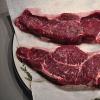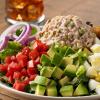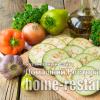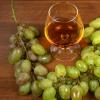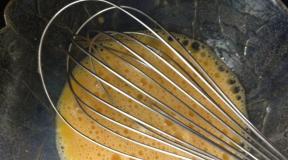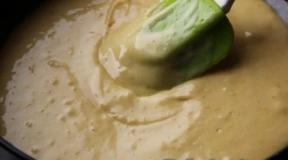How to calculate meals in the dining room. Calculation of the cost of a dish
It's no secret that all enterprises that do not operate in accordance with the Collection of Recipes (Technological Standards) are required to develop a "Technical and Technological Map" document. However, not everyone understands how the TTK differs from the Technological Map, and what it should look like. In this article we will give a detailed answer to this question.
So, the requirements for the design of the TTK and the information contained therein are set out in detail in GOST 31987-2012. We will not describe in detail the contents of GOST; we will limit ourselves to describing the main features.
Unlike the Technological Map, in the Technical and Technological Map, along with calorie content calculation, indication of the scope of application, requirements for raw materials and requirements for sales and supply, it is necessary to calculate and indicate the following indicators:
- Organoleptic indicators
- Physico-chemical indicators (mass fractions)
- Microbiological indicators for the corresponding food group
Below we present the methodology for developing the TTK and describe in detail the calculation of all the necessary indicators. This methodology is based on the Methodological Instructions, and all documents are generated automatically in the program for chefs and technologists “Chef Expert”.
Let's consider, for example, the calculation of all indicators for the TTK for the dish "Odessa Sausages"
|
1. Calculation of the nutritional and energy value of a dish |
||
|
We calculate the nutritional and energy value of a dish based on the methodology given in the Guidelines for laboratory quality control of public catering products, M., 1997, (Letter No. 1-40/3805 dated November 11, 1991) (Part 2). |
||
|
1.1. We determine the protein content in the first ingredient of the recipe - “Fat mesh (Pryatine)”. We find the protein content in 100 grams of the ingredient using reference tables of chemical composition recommended for use by the Federal Service for Surveillance in the Sphere of Consumer Rights Protection and Human Welfare (Rospotrebnadzor). Protein content in 100 grams of the ingredient “Fat mesh (Pryatine)” = 1.4 grams. Net weight of the ingredient “Fat mesh (Pryatine)” according to the recipe = 42 grams, therefore, the amount of protein in the ingredient = 42/100 * 1.4 = 0.59 grams (art. 7 in part 1). This ingredient is SUBJECT to heat treatment, therefore, protein loss during heat treatment is determined according to reference data = 10% (Article 10 in Part 1). Thus, the total amount of protein in the ingredient = 0.59*(100-10)/100 = 0.53 grams. (Art. 14 in Vol. 1) |
||
|
1.2. The ingredient “Fat mesh (Pryatine)” HAS NO TECHNOLOGICAL LOSSES after heat treatment (Article 13 in Part 1), therefore the total amount of protein in the ingredient = 0.53*(100-0)/100 = 0.53 grams. |
||
|
1.3. The ingredient “Fat mesh (Pryatine)” IS taken into account in the yield of the dish (Article 17 in part 1), therefore the protein content is taken into account in the total protein content in the dish. |
||
|
1.4. Similarly, we determine the content of carbohydrates and fats in the ingredient. |
||
|
1.5. In the same way, we determine the content of proteins, fats and carbohydrates for all ingredients in the dish, and enter the data obtained into Table 1. |
||

|
2. Calculation of the mass fraction of dry substances * |
||
|
2.1. We determine the content of dry matter in the first ingredient of the recipe - “Fat mesh (Pryatine)”. The content of dry substances in 100 grams of the ingredient is determined from reference tables of chemical composition recommended for use by the Federal Service for Surveillance in the Sphere of Consumer Rights Protection and Human Welfare (Rospotrebnadzor). The content of dry substances in 100 grams of the ingredient “Fat mesh (Pryatine)” = 94.3 grams. Net weight of the ingredient “Fat mesh (Pryatine)” according to the recipe = 42 grams, therefore, the amount of dry matter in the ingredient = 42/100*94.3 = 39.61 grams. |
||
|
2.2. The ingredient "Fat mesh (Pryatine)" HAS NO TECHNOLOGICAL LOSSES after heat treatment (Article 13 in Part 1), therefore the total amount of dry matter in the ingredient = 39.61*(100-0)/100 = 39.61 gram. |
||
|
2.3. The ingredient “Fat mesh (Pryatine)” IS taken into account in the yield of the dish (Article 17 in part 1), therefore the content of dry matter is taken into account in the total content of dry matter in the dish. |
||
|
2.4. Similarly, we determine the dry matter content for all ingredients in the dish and sum up the resulting values. |
||
|
2.5. To convert the dry matter content in a dish into a percentage, multiply the resulting amount by 100 and divide by the portion yield (100 grams). |
||
|
2.6. We sum up this percentage with the maximum permissible salt content in the dish = 1.33%. Thus, we obtain the Maximum (theoretical) dry matter content in the dish = 62.39%. |
||
|
2.7. The minimum permissible content of dry substances is calculated using the formula: for first courses and sauces: 0.85*Maximum content of dry substances, for other dishes: 0.9*Maximum content of dry substances. 0.85 and 0.9 are coefficients that take into account the loss of dry substances during the cooking process and permissible deviations when portioning dishes. Thus, min. permissible dry matter content in the dish = 62.39 * 0.9 = 56.15%. |
||
|
* In accordance with Appendix 2 of the Guidelines for laboratory quality control of public catering products, M., 1997, (Letter No. 1-40/3805 dated November 11, 1991), in this category of dishes the mass fraction of dry substances is DETERMINED during laboratory analysis. |
||
|
3. Calculation of fat mass fraction** |
||
|
3.1. We determine the amount of net fat in the ingredient “Fat mesh (Hide)” (the mass fraction of fat is taken into account only in the main fat-containing ingredients (butter, sour cream, milk, etc.)), by multiplying the net mass of the ingredient (in grams) by the fat content (in scales per 100 g of ingredient, or in %) and division by 100. Data on the content of natural fat in cereals, meat products, etc. neglected. MJ = 42/100*0 = 0 grams. |
||
|
** In accordance with Appendix 2 of the Guidelines for laboratory quality control of public catering products, M., 1997, (Letter No. 1-40/3805 dated November 11, 1991), in this category of dishes the mass fraction of fat is NOT DETERMINED during laboratory analysis. |
||
|
4. Calculation of the mass fraction of sugar *** |
||
|
4.1. We determine the amount of pure sugar in the ingredient “Fat mesh (Pryatin)” (the mass fraction of sugar in terms of sucrose is taken into account only in granulated sugar, refined sugar, powdered sugar, etc.), by multiplying the net mass of the ingredient (in grams) by the content sugar (in grams per 100 g of ingredient, or in%) and dividing by 100. MDS = 42/100*0 = 0 grams. |
||
|
*** In accordance with Appendix 2 of the Guidelines for laboratory quality control of public catering products, M., 1997, (Letter No. 1-40/3805 dated November 11, 1991), in this category of dishes the mass fraction of sugar is NOT DETERMINED during laboratory analysis . |
||
|
5. Calculation of mass fraction of salt **** |
||
|
**** In accordance with Appendix 2 of the Guidelines for laboratory quality control of public catering products, M., 1997, (Letter No. 1-40/3805 dated November 11, 1991), in this category of dishes the mass fraction of salt is DETERMINED during laboratory analysis . |
|
|
6. Microbiological indicators |
|
|
6.1. To determine microbiological quality indicators, we are guided by the Technical Regulations of the Customs Union TR CU 021-2011 “On the safety of food products”. |
|
A correctly formed technical and technological map looks like this:


In general, the process of developing a TTK is not particularly difficult if you develop documents using a special program. Calculating all the indicators on a calculator is very time-consuming and ineffective. You can learn more about the program for developing Technological Documentation "Chef Expert" on the official website
calculating the amount of waste, the yield of semi-finished products, gross weight, net weight, mass of the finished product.
1. Calculation of the amount of waste during mechanical culinary processing
(M otkh.) :
M otkh.=M b*O/100, where
M waste - mass of waste during mechanical culinary processing, g (kg);
M b – gross mass, g (kg);
2. Calculation of the yield of semi-finished products (Mp/f):
M p/f=M b*B p/f/100, where
M p/f – weight of the semi-finished product, g (kg);
M b – gross weight, g (kg)
In semi-finished product – yield of semi-finished product, %
3. Calculation of gross mass (M b):
M b=M n *100/(100-O), where
M b – gross mass, g (kg);
M n – net weight, g (kg);
О – waste from mechanical culinary processing, %
4. Calculation of net mass (M n):
M n = M b*(100-O)/100, where
M n – net weight, g (kg);
M b – gross mass, g (kg);
О – waste from mechanical culinary processing, %
5. Calculation of the mass of the finished product (M ready):
M ready = M n * (100-P t.o.)/100, where
M n – net weight, g (kg);
M n=M ready*100/(100-P so), where
M n – net weight, g (kg);
M goth. – mass of the finished product, g (kg);
P t.o. – losses during heat treatment, %
6. Formulas for calculating the nutritional and energy value of culinary products:
6.1 Content of nutrients in the product (K):
K=M N *TO spr /100, where
МН – net mass of the product according to the recipe, g;
6.2 Amount of food substance after heat treatment (P):
P=ΣK*P spr /100, where
P – amount of food substance after heat treatment (g, mg, μg);
ΣK – total content of the desired nutrient in the dish (g, mg, μg);
P spr – preservation of food substances in a dish in accordance with the reference book, %.
6.3 P spr = 100 – P p.v. (%), Where
P p.v. – loss of food substances as a result of heat treatment (according to the reference book), %.
Appendix 3
DEVELOPMENT OF TECHNOLOGICAL MAPS
A technological map for public catering products is a technical document compiled on the basis of a collection of recipes for dishes, culinary products, bakery and flour confectionery products or a technical and technological map. The technological map indicates the name of the enterprise, the source of the recipe (Collection of recipes, the year of its publication, the number and version of the recipe, or the surname, first name, patronymic of the author, the year and number of the technical and technological map).
When describing the recipe, the consumption rate of products per 1 serving (per 1000 g) in grams and for the most frequently repeated batches of products produced at a given enterprise in kg are indicated. Recipes indicate the amount of salt, spices, herbs and other products, which in collections are usually indicated in the text or in table 28 “Consumption of salt and spices when preparing dishes and products.”
The technology for preparing a dish, culinary or confectionery product is described sequentially, indicating the equipment and inventory used. When describing the technology, indicate the parameters of the technological process: duration of heat treatment (min), temperature (°C), etc.; order of presentation and serving of food. Organoleptic quality indicators are given: appearance, consistency, color, taste and smell.
In accordance with the rules for the provision of public catering services, the manufacturer of culinary products is obliged to inform consumers about the nutritional and energy value of dishes, culinary, flour and confectionery products. Therefore, it is recommended to provide information on the nutritional and energy value of the dish (product) in the technological map.
Appendix (A2) provides a sample technological map.
procedure for releasing food to the canteen from the warehouse
After the ration products are distributed among the dishes, their yield is calculated.
The yield of the first course should be 0.7 liters, including the thick portion (cereals, vegetables, potatoes) of at least 30g, viscous porridges - 280 - 320 g (if cereal is added 70 - 80 g), mashed potatoes (300 - 400 g when adding 400g potatoes).
The yield of the second course is determined depending on the weight of the meat (fish) portions and side dish. Output of meat (fish) portions into your own. The queue depends on the type and fatness of the meat (type and variety of fish) and fluctuates within the limits indicated in the table.
|
Boiled and stewed meat |
Grilled meat |
chopped |
|
|
Beef | |||
|
Mutton | |||
Yield of fish portions from 100 g of fish.
Boiled fish
Fried fish
Fresh pike perch, bream,
pike, etc. Salted pike perch, bream,
pike, etc.
Fresh cod
(gutted, without
Salted cod
(gutted without
To determine the yield of the second dish, which, for example, includes: meat - 100 g, potatoes - 430 g, onions - 20 g, combined fat - 10 g, using the table (Appendix 22) we find the yield of mashed potatoes from 100 g of potatoes. For the period March - April, this yield is 84%, or from 430 g of potatoes we get 430 x 84 = 361 g of mashed potatoes. Output of onions
sautéed is 61%, or 12 g. The weight of the combined fat remains practically unchanged. Therefore, the yield of the finished puree will be 361 + 12 + 10 = 383 g. From the same table we find that the yield of boiled meat from beef of the 1st category as a whole from a carcass or half-carcass is 46%, i.e. 46g; This yield is recorded in the column “Weight of meat (fish) portions.” Thus, the total yield of the second course will be 383 + 46 = 429 g.
The weight of cereals and other dishes is calculated in the same manner (Appendix 23, 24 and 25).
Based on the total consumption of food for a particular meal (breakfast, lunch, dinner), the content of proteins, fats, carbohydrates and calorie content is determined using the table of caloric content of foods according to ration norms.
If necessary, the content of vitamins and minerals is calculated using the same method from the table. These data are calculated by the senior doctor (paramedic) of the unit.
The final data on the content of proteins, fats, hydrocarbons in the diet, as well as on caloric content, are compared with the same data on the allowance standards for soldiers' rations, and in case of large discrepancies, they are checked and the reason for the discrepancies is determined.
Lesson No. 3 Organization of the work of the cook staff and daily dining attire.
Preparing the dining room, setting tables,preparing food for distribution
Control-indicative cooking
Diet food
Sanitary and hygienic requirements for military food
Consumption rate raw materials is the mass of raw materials in kilograms spent on the production of 1 ton of the finished product.
Taking into account formula (7), the mass of raw materials spent to obtain 1 ton of the finished product is calculated using the formula
Where R c – rate of consumption of raw materials, kg per 1 ton of product; n– maximum permissible losses, %.
Based on actual data, it can be established actual consumption raw materials:
Where R f – actual consumption of raw materials, kg per 1 ton of product; m With, m g – the mass, respectively, of the actually consumed raw materials and the resulting product, i.e.
Theoretical flow raw materials are calculated without taking into account losses:
 (14)
(14)
Currently, the following formulas are accepted in industry when calculating consumption rates for individual products.
Consumption rate of normalized milk per 1 ton of pasteurized milk:

Where n g – maximum permissible fat loss during cream production, % of fat mass in processed milk.
Milk consumption rate per 1 ton of cream

Where AND ob – standard mass fraction of fat in skim milk, %; Consumption rate of normalized milk per 1 ton of fat cottage cheese

Where AND g – degree of fat utilization, %.
Consumption rate of skim milk per 1 ton of low-fat cottage cheese

where 237.4 is the amount of protein required to produce 1 ton of low-fat cottage cheese with a moisture mass fraction of 77.5%, kg; B ob – actual mass fraction of protein in skim milk, %; TO– coefficient that takes into account the loss of skim milk for acceptance, pasteurization, storage and packaging.
With an annual milk processing volume of up to 10,000 and from 10,001 to 25,000 tons K= 1.0028 from 25001 to 50000 t – K= 1.0021, from 50001 t and above K = 1,0017.
Milk consumption rate per 1 ton of butter
Where AND cl, AND m – mass fraction of fat, respectively, in cream (at which the standard mass fraction of fat in buttermilk is established) and in milk, %; AND life safety fundamentals ms, AND nx – standard mass fraction of fat in skim milk, butter, buttermilk, respectively, %; n g1 – maximum permissible fat loss during cream production, % of fat mass in milk processed into butter; P g2 – maximum permissible fat loss when processing cream into butter, % of fat mass in cream.
Consumption rate of normalized milk per 1 ton of mature cheese
Where AND d.v – standard mass fraction of fat in the dry matter of mature cheese, %; INс – standard mass fraction of moisture in cheese; %; TO– correction factor for the result of analysis of a cheese sample taken with a probe (for hard rind cheeses 1.036, for rindless cheese 1.025, for soft cheeses 1); ABOUT t – waste rate of cheese mass, % of the mass of produced cheese; P g – maximum permissible fat loss during cheese production, % of fat mass in normalized milk; ABOUT g – rate of fat loss into whey, %.
Consumption rate of skim milk and buttermilk per 1 ton of low-fat cheese and feta cheese

Where Pm– mass fraction, respectively, of moisture in mature cheese, dry substances in skim milk or buttermilk, %; ANDс – degree of use of dry substances of raw materials.
Consumption rate of normalized milk per 1 ton of whole milk powder

Where WITH dry m, WITH n.m – mass fraction of dry substances, respectively, in the finished product, normalized milk, %; n d.v – maximum permissible loss of dry substances, % of the mass of dry substances in processed normalized milk.
Yield of the finished product IN(in%) is the mass of the finished product obtained from one hundred units of raw materials. The product yield is calculated using the formula

To assess the commercial properties of processed milk, it is advisable to calculate the yield without taking into account production losses, since they depend on the volume of processed raw materials.
The yield of dairy products can be determined by one of the components of milk, taking into account the degree of its use;
![]()
Where h n.m – mass fraction of milk components in normalized milk, %
The yield of dairy products depends on the content of fat, protein, lactose and other components of milk in the initial raw materials, forming the bulk of the product, on the degree of their transition into the finished product and on the mass of moisture in the product with the components of milk dissolved in it.
For example, when separating milk, determine the yield of cream and the rate of milk consumption if the mass fraction of fat in milk is 4%, in cream - 35%, in skim milk - 0.05%. Production losses amount to 0.15%.
The yield of cream will be like this

Consumption rate of whole milk per 1 ton of cream

Chapter 2. CALCULATIONS FOR NORMALIZATION OF RAW MATERIALS
WHOLE MILK PRODUCTS
In the production of such types of products as drinking milk, curdled milk, kefir, etc., milk is standardized for fat, and for some products, for dry substances. The fat content in the finished product, specified by the standard, is equal to the fat content in normalized milk, since there is no waste in the production of these products.
Milk is normalized for fat by mixing: periodically or continuously in flow using separator-normalizers.
When normalizing milk by mixing in a periodic manner, normalized milk is obtained by mixing the original whole milk T m with cream m sl, if the fat content of normalized milk is higher than the fat content of the original milk ( T n.m = T m + t With l), or by mixing with skim milk, if the fat content of normalized milk is lower than the fat content of the original milk
(T n.m = T m + T about) .
The mass of cream or skim milk required for normalization can be determined using material balance equations.
If AND n.m.< AND m then, in accordance with the material balance equations, we have

Solving this system of equations, we will find the mass of skim milk necessary for normalization,

and the mass of whole milk

To obtain the required mass of skim milk, it is necessary to separate a certain mass of whole milk m Sep. According to the material balance equations

Solving this system of equations, we derive a formula for determining the mass of milk that needs to be separated:

If AND n m > AND m, then

By solving this system of equations, we find the mass of cream necessary to normalize milk,

and the mass of whole milk

If there is no cream in production for normalization, then in this case it is necessary to obtain it by separating a certain mass of milk m Sep.
In accordance with the material balance equations, we have

Solving this system of equations, we obtain a formula for determining the mass of milk for separation

When normalizing milk in a continuous stream, two cases occur: when the fat content of normalized milk is greater than that of whole milk, and vice versa.
If AND n.m.< AND m then T m = t n.m + t sl.
In this case, the mass of normalized milk is calculated using the formula

and the mass of cream that needs to be isolated for normalization is

If AND n. m >F m then T m = t n.m. + t about .
In this case, the mass of normalized milk is determined by the formula

and the mass of skim milk is

All these calculations can be performed graphically using the calculation triangle.
Milk is normalized for dry substances by adding powdered or condensed skim milk to the original whole milk in accordance with the material balance equation.
When determining the mass of milk powder, its solubility and moisture content are taken into account. The mass of milk powder for normalization is calculated using the formula

Where T 1 – mass of milk powder according to the recipe, kg; R– solubility of milk powder, %.
From raw materials 25
The standards should include the percentage or index of cost reduction, increase in labor productivity, yield of finished products from the raw materials used, efficiency and other similar indicators that characterize the quality of work as a whole or its individual elements. A unified system of norms and standards is being created.
The formation of a system of norms and standards is carried out on the basis of economic and engineering calculations. Therefore, it is necessary to take into account progressive scientific and technical achievements that make it possible to improve norms and standards, for example, increasing the yield of finished products per unit of raw materials, increasing the utilization rate of equipment, reducing labor intensity, etc. Therefore, when forming them, it is necessary to include resource saving tasks in the calculations or indicators of savings of fixed production assets, material costs and wages in the field of material production.
The power of batch machines depends on the number of revolutions, or cycles, in a given phase of production, the amount of raw materials consumed per revolution or cycle, and the output of finished products from a unit of raw materials.
In the sub-sectors of the oil refining and petrochemical industry, to characterize the use of material resources, an indicator of the consumption of material resources for the production of a unit of output in physical terms is also used (including fuel consumption for the production of 1 million tons of petroleum products, etc.). In addition, various coefficients are calculated that reflect the use of raw materials, fuel, energy, materials, indicators characterizing the output of finished products per unit of raw materials.
The system of technical and economic norms and standards presupposes their interrelation and interdependence. For example, an increase in the output of finished products from a unit of raw materials per unit of time directly affects the indicator of equipment utilization, the growth of labor productivity, the capital productivity indicator, which increases, etc. cost level, profit margin, etc.
One of the features of accounting for products in production is that consumed raw materials are written off not according to actual costs, but according to the investment rates provided for in the Collection of Recipes for Dishes and Culinary Products. In this regard, it is important to organize operational control over the correct investment of products and strict adherence to standards for the yield of finished products. Enterprise managers and production managers are required to periodically attend the loading of products and check their compliance with established standards, as well as constantly monitor the quality and weight of the finished products produced.
The maximum possible reduction of these types of inventories in work in progress helps to improve the use of working capital by reducing the duration of the production cycle. In a continuous production process at chemical industry enterprises, it is calculated from the moment raw materials are launched into production until the finished product is released. In general, for the enterprise (workshop) the average duration of the production cycle is determined by the method of weighted average indicator of the duration of production cycles of individual products or most of them by their cost.
Thorough mixing of the initial mixture and the extractant in order to increase the contact surface between the phases; separation of two immiscible liquid phases (extract and raffinate). Regeneration of the extractant, removing it from the extract and raffinate. Release of devices by gravity or compressed air. Maintenance of multi-stage extractors, diffusers and extraction columns operating on the countercurrent principle, dispensers, separators, traps, centrifugal pumps, instrumentation. Accounting for raw material consumption and finished product yield.
Suspension of the operation of the unit during a continuous production process immediately leads to a decrease in product removal from it, a decrease in the yield of the finished product from processed raw materials, deterioration in quality and the formation of defects.
Preparation for taking a double-sided photograph of a working day, in comparison with an individual photograph of a working day, includes such additional activities as familiarization with the characteristic deviations of the technological regime from the norm and ways to regulate it, the selection of technological process indicators (regime parameters, the amount of processed raw materials or semi-finished products, output finished products, etc.), the values of which are supposed to be recorded during observation. The frequency of recordings of each of them is also selected, the frequency of which depends on the stability of the technological regime.
In the industries of primary processing of raw materials, the indicator of yield or extraction of the finished (usable) product from the original raw material is used (yield of suitable casting, yield of cotton fiber from raw cotton, yield of copper from ore, yield of sugar from beets, etc.). There are planned and actual. yield of finished (usable) products from raw materials. A comparison of these indicators makes it possible to judge the extent to which the enterprise has fulfilled the planned target for the use of raw materials.
Vgf - factual yield of suitable (finished product from raw materials) G - the amount of suitable products produced Yas - the amount of raw materials actually spent for the production of this product. For example, from a ton of metal filling in a foundry, 650 kg of suitable casting was actually obtained. In this case the output
The importance of rational use of material resources (MR) is determined, first of all, by their significant share in the cost of production. The economical use of raw materials and materials ensures an increase in the yield of finished products from the same amount of resources, a reduction in the cost of manufacturing products, an increase in profits and an improvement in other technical and economic performance indicators. Material costs include a) raw materials, b) auxiliary materials, c) fuel and d) energy.
Economic calculations associated with planning at the present stage are characterized by great complexity, close relationships, and the work of enterprises is multivariate. For example, any technological installation can operate in different modes, and the output, costs and other indicators will be different. Finished products at oil refineries are obtained by mixing; the mixing recipes for many of them are not regulated in advance, i.e., the components are involved in the finished product in different proportions depending on operating conditions. One and the same technological installation can operate on different types of raw materials (for example, gas fractions of different compositions and straight-run gasoline can be used for pyrolysis).
Historically, banks have been “favorable” to manufacturing companies regarding loan terms. Accounts receivable as a result of the shipment of products, inventories of raw materials, finished products and even technological processes were considered collateral that could be realized relatively quickly. Lending institutions viewed the building and equipment as maintaining or even increasing their collateral value over time. The reason for this predisposition of banks towards manufacturing enterprises was the opportunity to sell the physical assets of the firm, which the bank could hold for debts. The right to lien property for debts is considered a secondary source of loan repayment, a backup option for getting out of an unsuccessful credit transaction.
INDICATORS OF THE USE OF RAW MATERIALS AND MATERIALS - indicators characterizing the level of their use in production. The main ones (planned and actual) are utilization and cutting coefficients, consumption coefficient of product yield (semi-finished product), coefficient of product extraction from raw materials. Utilization coefficient is the ratio of the useful consumption of material, etc. to the consumption rate established for the production of a unit of product (work, services). For example, the mass of a part is 12 kg, the metal consumption rate is 16 kg, the utilization factor is 0.75 (12/16), thus, 25% of the metal goes to waste. Consumption coefficient is the ratio of the rate of consumption of materials (raw materials) established for the production of a unit of product (work, services) to their useful consumption, an indicator inverse to the utilization coefficient. Cutting coefficient is the ratio of the mass (volume, area, length) of all types of workpieces obtained from the source material to the mass (volume, area, length) of the used one. For example, from 5 m2 of raw materials, 4 m2 of finished products are obtained, the cutting coefficient is 0.8 (4/5), thus, the degree of material utilization when cutting is 80%. Yield of product (semi-finished product) - the ratio of the amount of produced product (semi-finished product) to the amount of actually consumed raw material
If the output for a work process is a product (product), then the input is a set of resources necessary to create this product. During the work process, these resources are consumed, some of them - completely for each work cycle, others - in parts over a number of repeating cycles. For example, in the production process, during the manufacture of each part, materials allocated for this in accordance with consumption standards are consumed simultaneously and in full, and equipment and human labor transfer only part of their cost to it. A repeatedly and long-term used (relatively permanent) component of the set of resources (production space, equipment and personnel) necessary for the implementation of a work process forms the physical basis of a work center for performing this process. The work center serves as a material shell within which the




